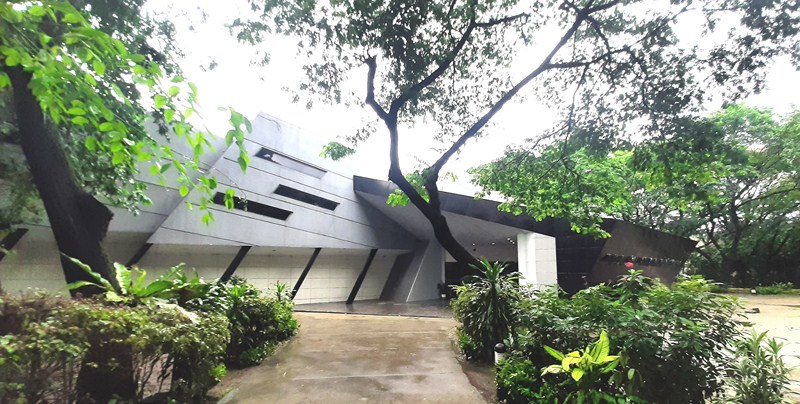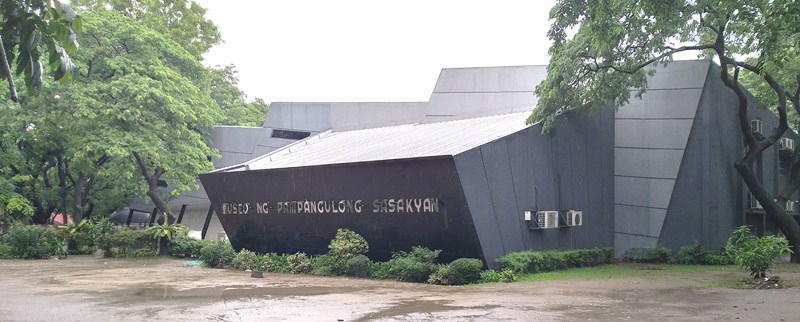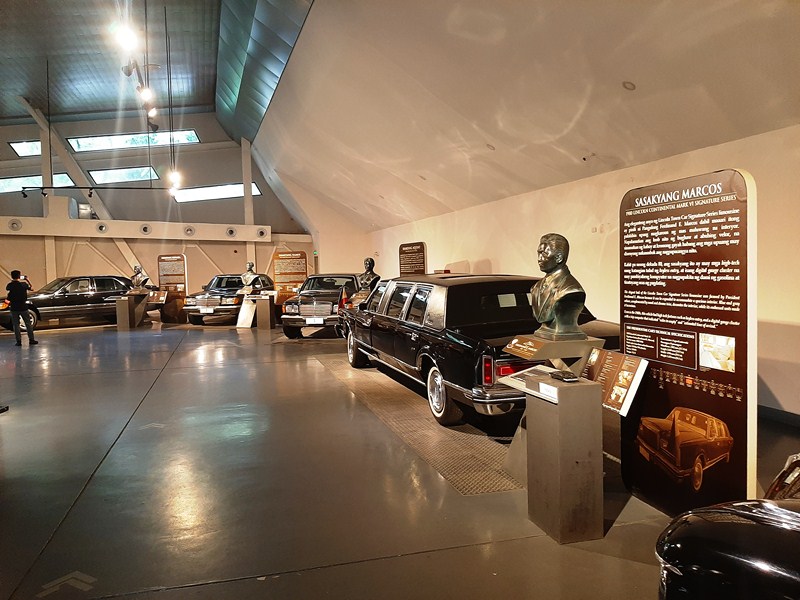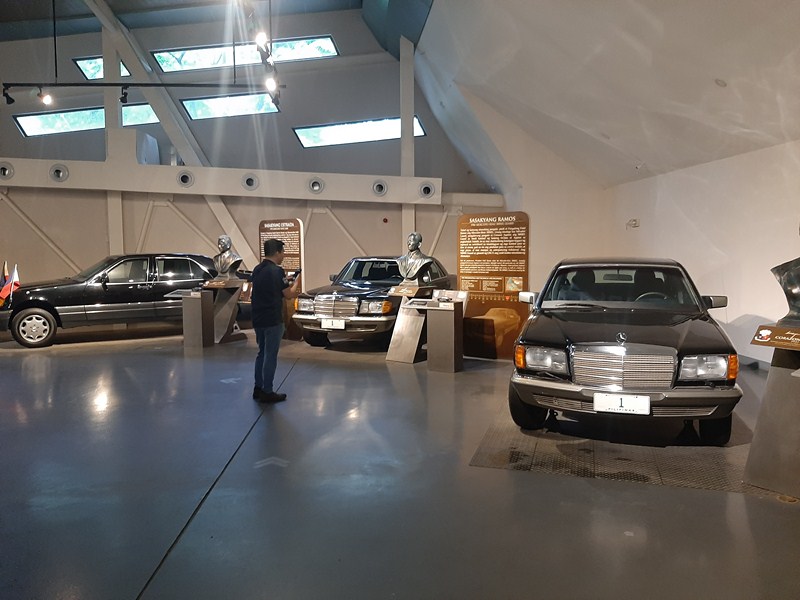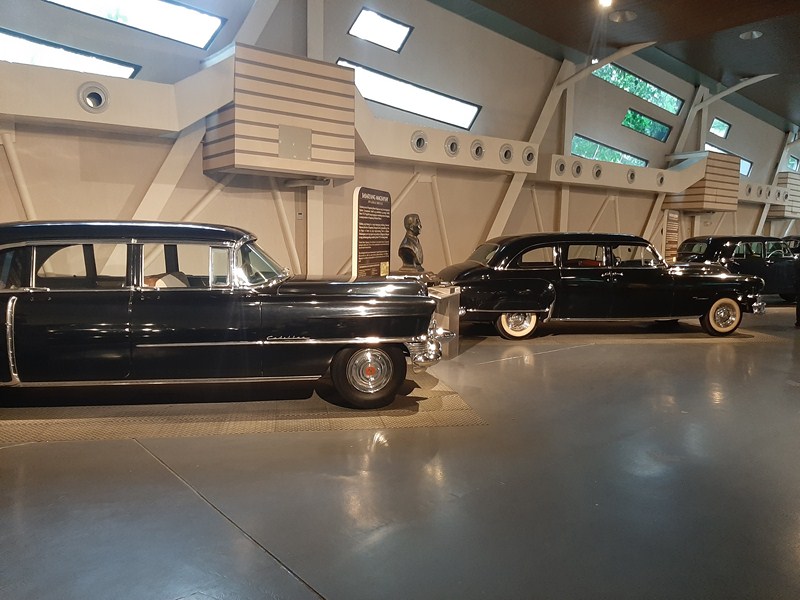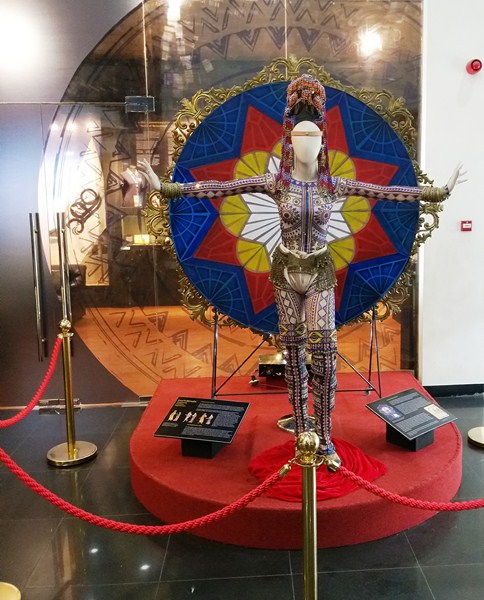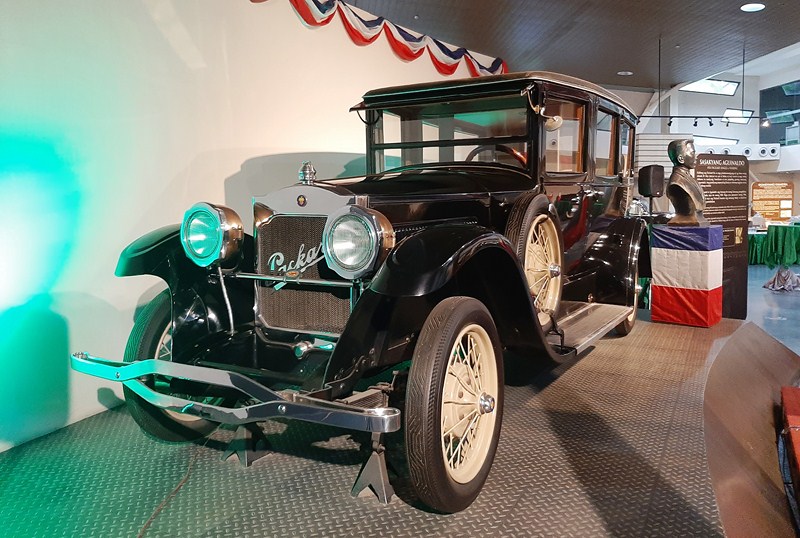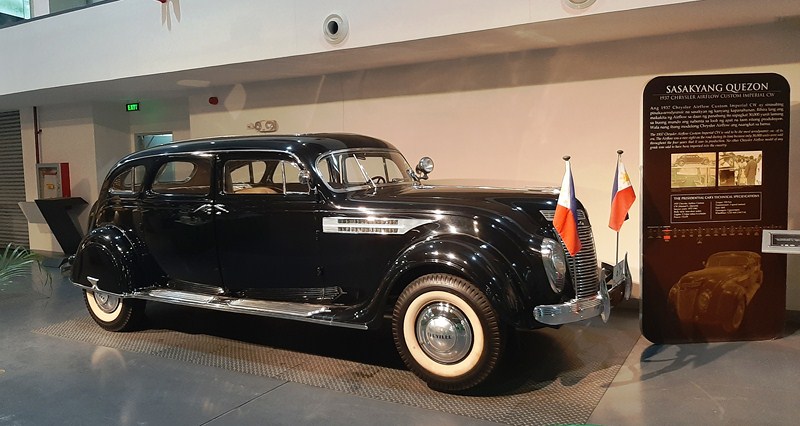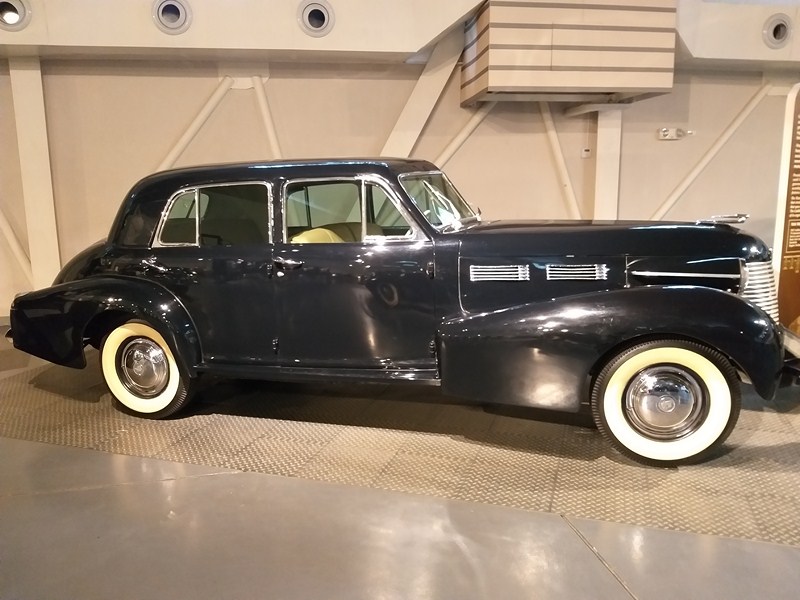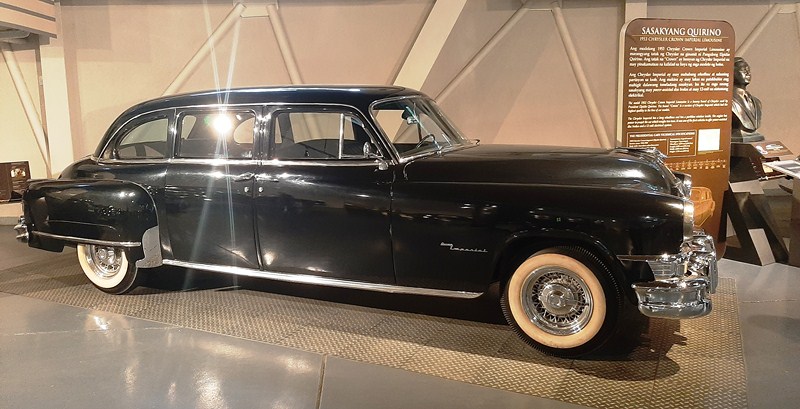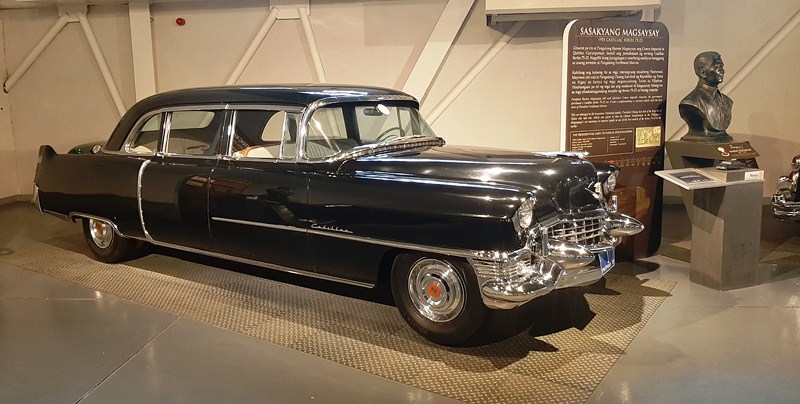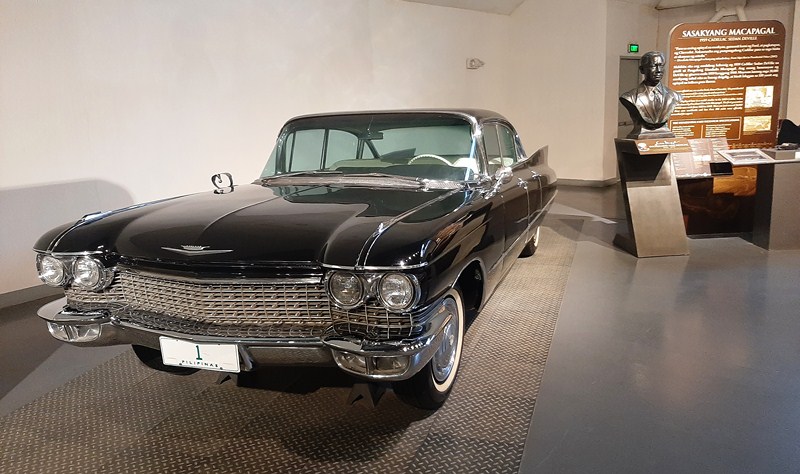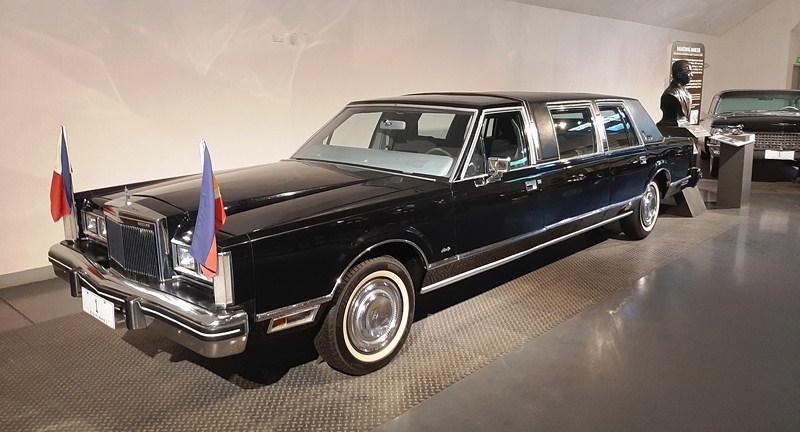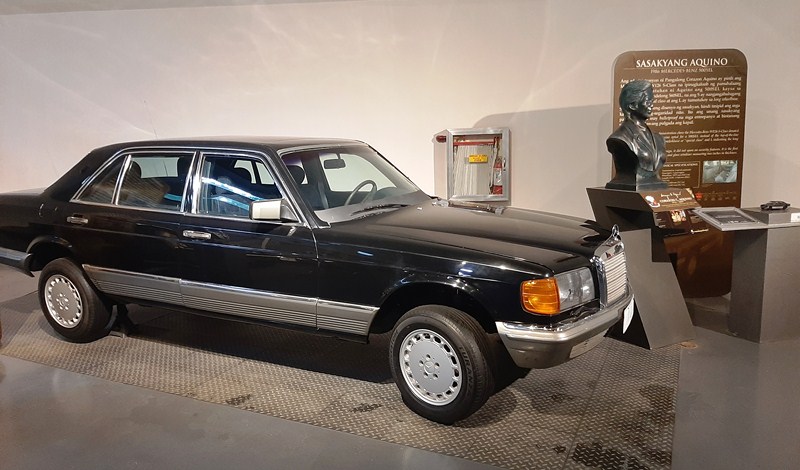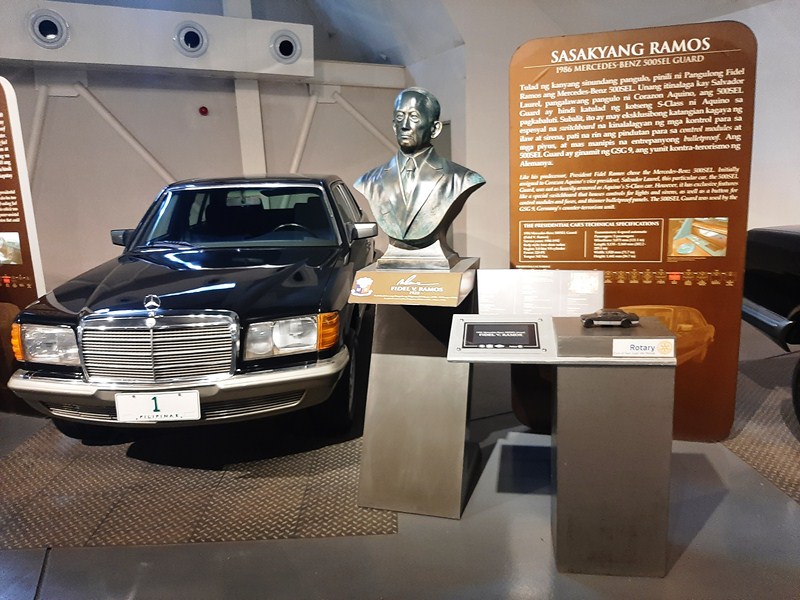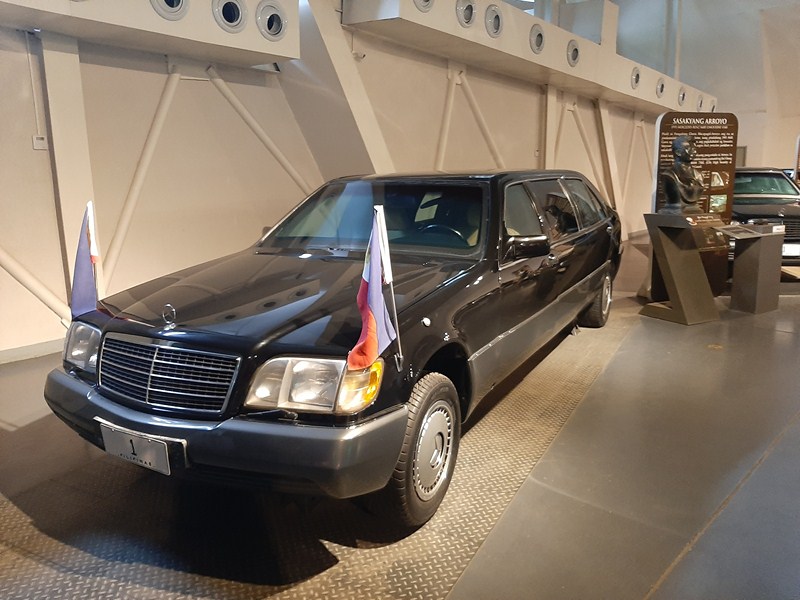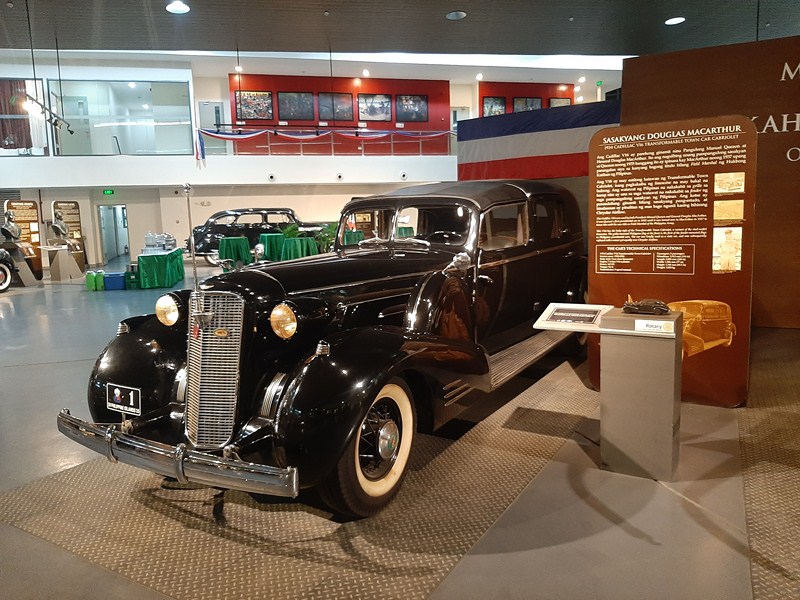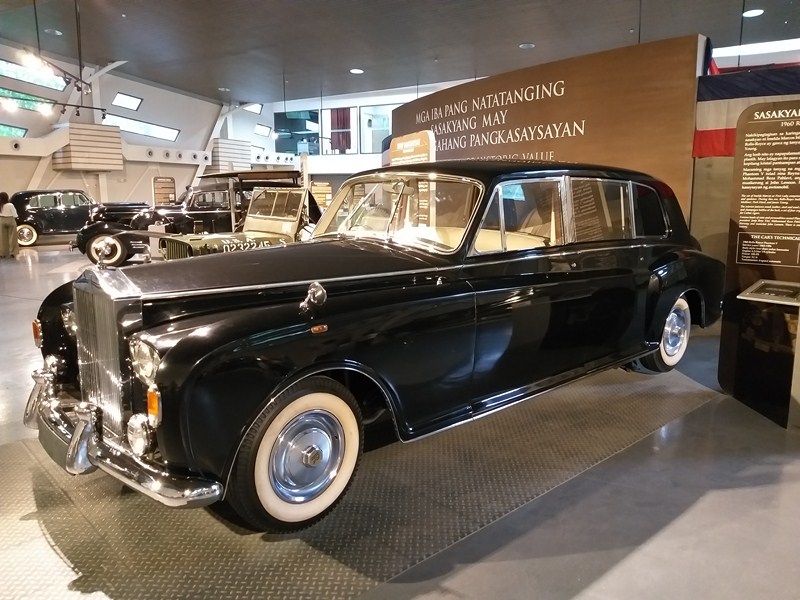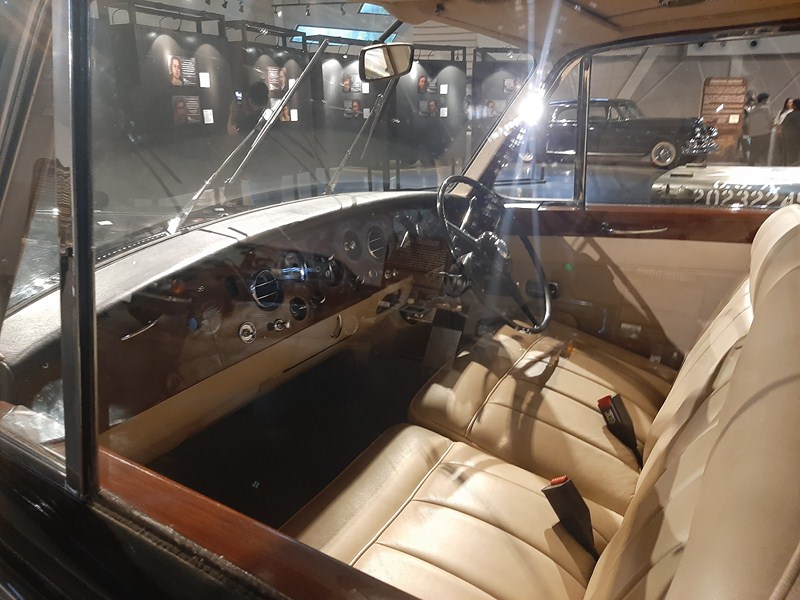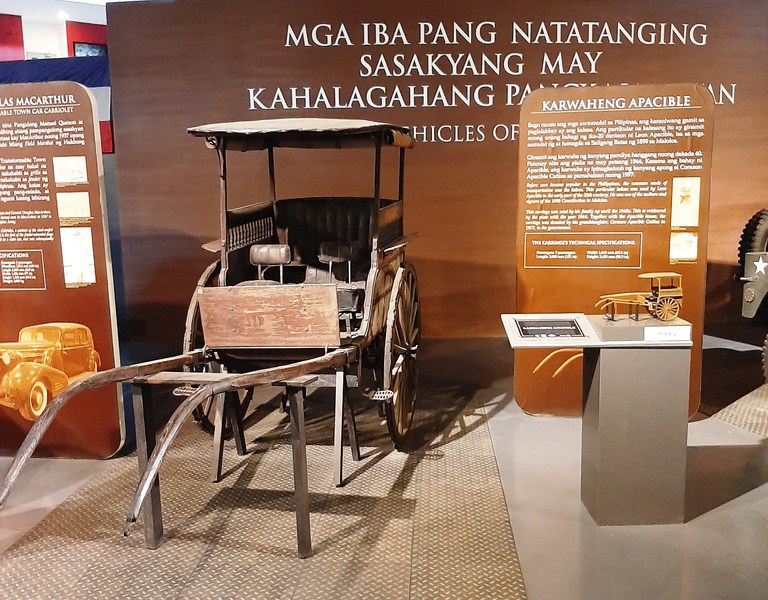The Presidential Automobile Museum (Filipino: Museo ng Pampangulong Sasakyan), within the Quezon Memorial Circle, houses the largest collection of state cars in the country. It displays the National Historical Commission of the Philippines (NHCP) collection of 12 interesting and unique cars used by 13 former Presidents of the Philippines during their term of office.
As early as 2013, the NHCP was planning to open a museum to house the presidential cars of former Philippine Presidents and, when it signed a memorandum of agreement with the local government of Quezon City, the NHCP secured a location for the museum.
Prior to the opening of the museum, the vehicles were housed in a private warehouse in Pampanga handled by the Presidential Security Group (PSG) while others were left in display in the garages of these former president’s homes. They were restored to their original condition by Quezon City resident Alfred Perez, whose atelier Alfred Motor Works (established in 1993), located at the corner of 11th Jamboree Street and Kamuning Road, specializes in the restoration of classic cars.
On land within the Quezon Memorial Circle (formerly occupied by basketball and volleyball courts which was moved to another part of the park at the NHCP’s expense), the city provided at least 3,000 sq. m. (32,000 sq. ft.) of space for the museum. On August 19, 2018, the triangular museum was formally inaugurated.
Each display includes the car’s history and specifications as well as the profile of its user. . Beside the cars are busts of the presidents that were created by Juan Sajid de Leon Imao (born 1971), son of the first Muslim National Artist for the Visual Arts Abdulmari Imao.
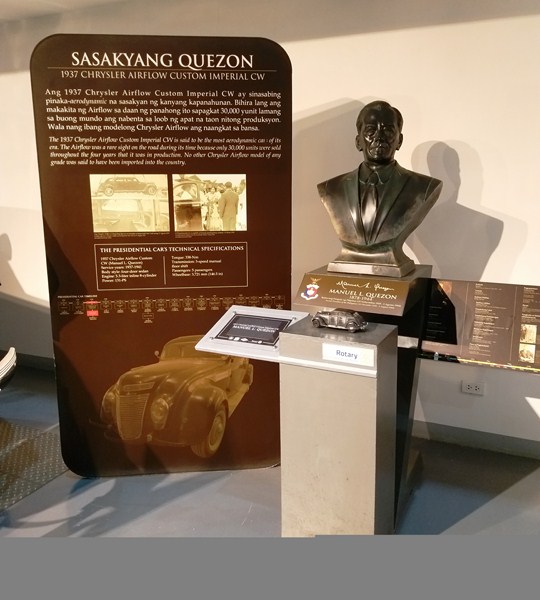
The display includes the car’s history and specifications as well as the profile and bust (created by Juan Sajid de Leon Imao) of its user.
By the entrance of the museum is parol-inspired National Costume of 2018 Miss Universe Catriona Gray.
The presidential car of Carlos P. Garcia (1896 – 1971) was never recovered. Presidents Benigno C. Aquino III (1960 – 2021) and Rodrigo R. Duterte (born 1945), who both used the more utilitarian Toyota Land Cruisers, do not have their cars in the museum as they are still being used.
The Packard Single Six Touring Model 233 Series 1924, the “retirement” (he rode a horse-drawn carriage during his presidency) car of Emilio Aguinaldo (1869-1964) from 1924–1964, is considered as one of the earliest US vehicles that were being exported worldwide for use as state transportation, it was used by the Russian Imperial family back then.
The car, originally displayed in Fort Santiago in Manila and the Aguinaldo Shrine in Kawit, Cavite, has wood and vinyl interiors. Its car plate, issued in 1936, bears the figures 1-1896, “1”” reserved as plate number of presidents, and “1896” the year the Philippine Revolution began.
The 1937 Chrysler Airflow Custom Imperial CW Limousine, the presidential car used by President Manuel L. Quezon from 1937-1941, came with a price tag, back then, of US$1,610. It was exclusively produced in 1937 to 1937 by the Chrysler Corporation. This car, one of the rarest automobiles in the world (there are only 10 or less in the world), is the only one in the Philippines. The most aerodynamic car of its era, was powered by an inline 8-cylinder engine producing 130 horsepower and designed with a 3-speed manual floor shift transmission
The 1942 Packard Customer Super 818 Limousine, the presidential car used by President José P. Laurel and his successor President Sergio Osmeña from 1941–1946, had the best fabrics, leather and carpeting, plus a wool ceiling, It also has a glass partition that can be lowered so anytime the president wants to drive on his own, then he can do so. Osmena’s own car, a 1941 Cadillac Series 1, is currently on exhibit at the Osmena Museum in Cebu.
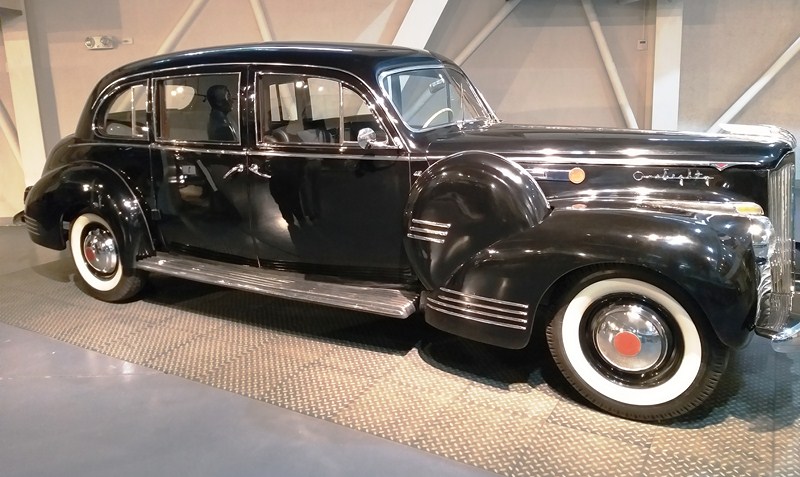
The 1942 Packard Customer Super 818 Limousine used by Pres. Jose P. Laurel and his successor Sergio Osmena
The 1947 Cadillac Fleetwood Series 75, the presidential car used by President Manuel Róxas from 1946–1948, is an Imperial 7-seater limousine, considered as the ultimate luxury automotive vehicle back then. It boasts Fleetwood coachwork, with a very imposing appearance and an impressive and detailed interior. This car is distinguished by a massive vertical grille that stretch out to the fenders in a large hood. Because of its engine, this Cadillac was considered one of the most powerful cars of its era.
The 1953 Chrysler Crown Imperial Limousine, the 8-seater presidential car used by President Elpidio Quirino from 1948–1953, is an innovative, 2-ton vehicle that had a long wheelbase and partition windows inside, power-assisted disc brakes (one of the first cars to offer them) and an electrical system with 12 volts power.
The 1955 Cadillac Series 75-23 Fleetwood, the presidential car used by President Ramón Magsaysay from 1953–1957 (he rode a 1953 Ford Crestline Convertible during his inauguration), was considered, back then, as the most expensive Cadillac, this car was a favorite choice to transport VIPs and world leaders. It was used until the early presidential term of President Fidel V. Ramos.
The 1959 Cadillac Sedan de Ville, not the actual unit but similar to the one used by President Diosdado Macapagal from 1961–1965, is considered as a rare asset as there were only 20,000 (of which less than 100 units officially earmarked for export) of this huge, extremely sharp, very much remembered and intimidating car model that was made available worldwide.
The 1980 Lincoln Continental Mark VI Signature Series, the elegant presidential car used by President Ferdinand Marcos from 1980–1986, is Lincoln’s flagship car due to sleek design, high quality and secure car features, boasts highly advanced features. It could be expanded to accommodate a spacious interior and had high-tech features such as keyless entry plus a more ‘digitized’ gauge cluster showing a trip computer which would let the driver and the passenger know the current status of ‘miles to empty’ and the ETA for every road trip.
The Mercedes-Benz 500 SEL is the relatively simple and understated looking presidential car used by President Corazon Aquino from 1986–1992. As safety has always been a concern for this president being in the center of a country revolution, this car had bulletproof panels and 2-inch thick glass windows.
The Mercedes-Benz 500 SEL Guard, the presidential car used by President Fidel V. Ramos from 1986–1992, had thinner panels and a built-in specific switchboard that gives control to the lights and the sirens plus buttons specifically for controlling compartments and fuses.
The Mercedes-Benz S600, the presidential car, initially assigned to Vice-President Salvador Laurel, was used by President Joseph Estrada from 1993–2001. Said to be one of the safest presidential cars due to its features, it boasts a self-sealing fuel tank, doors with thick steel plates and Kevlar used in bulletproof vests plus protection from detonating devices and a unique alarm system. A television set and a telephone system was also installed.
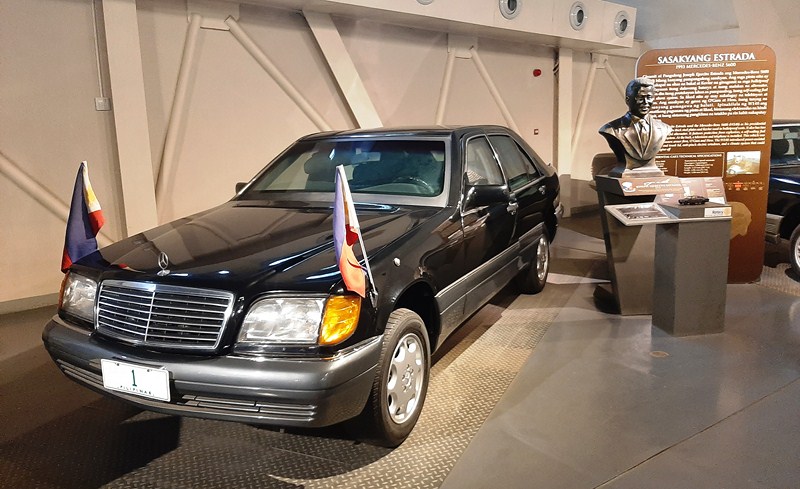
The Mercedes-Benz S600, initially assigned to Vice-Pres. Salvador Laurel, and used by Pres. Joseph E. Estrada
The 1993 Mercedes-Benz S600 (LWB) S600 V140 Limousine, the presidential car used by President Gloria Macapagal Arroyo (born 1947) from 1993–2001,is a stretch limousine said to be the country’s longest and largest state vehicle. It was heavily armored and had run-flat tires with engine block protective covering against any sharpshooters.
Four cars in the collection are classified as “other vehicles of historical value.” The 1935 Cadillac V-16, a transformable town Cabriolet used by President Manuel Quezon as his presidential car, from 1935–1936, was the first car with a Philippine flag. It had a steel roof and a grilled fender. The car was soon turned over to General Douglas MacArthur (1880-1964) in 1937 to honor him as the new Field Marshal of the Philippines.
The 1943 Willy’s Jeep, donated by General Douglas MacArthur, was used by Ramón Magsaysay during his tenure as Secretary of National Defense, during the term of President Elpidio Quirino, as his service vehicle from 1950–1953. Resembling its military counterpart, it had a dependable shovel, gas tank and collapsible radio antenna.
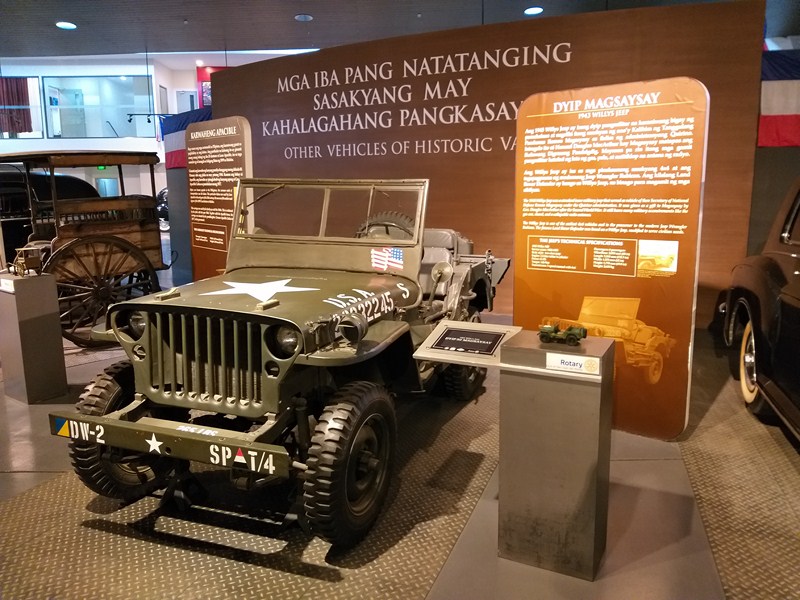
The1943 Willy’s Jeep, donated by Gen. Douglas MacArthur, and used by Sec. of National Defense (and later president) Ramon Magsaysay
The 1960 Rolls-Royce Phantom V, used by Imelda R. Marcos (born 1929) from 1965–1986. was one of only 516 models that exist and were produced worldwide.
Its interiors had a storage for wine and champagne bottles at the back, a set of four-crystal champagne flutes and a built-in humidor for Cuban cigars. Other famous celebrities who owned this kind of car include Queen Elizabeth II, Shah Reza Pahlavi (the last shah of Iran) and John Lennon of The Beatles.
A kalesa, used until 1940, was owned by the family of judge and revolutionary León Castillo Apacible(1861-1901), a member of the commission that drafted the Malolos Constitution.
The museum also has an audio-visual room, a resource center, a multi-purpose area, a souvenir shop and an interactive Wall Alive feature. The museum also showcases a special section on political figures that also shaped the country’s history.
Presidential Car Museum: Quezon Memorial Circle, Elliptical Rd., Quezon City, Metro Manila. Mobile number: (0945) 470-0436, (0905) 435-339 and (0920) 698-1954. E-mail: pcm@nhcp.gov.ph and presidentialcarmuseum@gmail.com. Open Tuesdays to Sundays, 9 AM to 4 PM. Admission is free. Coordinates: 14°39′0.7″N 121°03′3.8″E.

